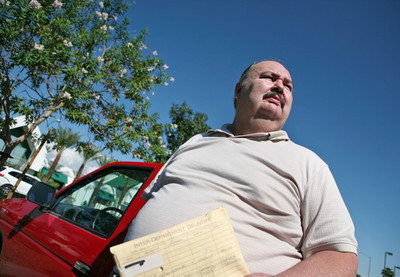Area 51 workers in twilight zone
A former Energy Department contract employee has been denied an illness compensation claim solely because he worked at Area 51, though federal officials years ago told base contract workers they would receive the same consideration as Nevada Test Site workers who became ill.
And that makes Fred Dunham think the Energy Employees Occupational Illness Compensation Program should be scrapped for a more fair system that follows a course Congress intended.
"I would terminate the whole lot of them and replace them with people who want to do the job at hand. Congress has tasked them with a job to do, and they have turned their back on Congress and the citizens," said Dunham, a 57-year-old Las Vegas resident.
He has chronic obstructive pulmonary disease that he blames on inhaling toxic, dioxin-laden fumes while he worked for EG&G Special Projects at the government's secret installation along the dry Groom Lake bed.
Labor Department officials don't dispute that his disease is linked to toxic materials from his workplace. But they denied his claim because the place where he worked was outside the boundary of the Nevada Test Site, according to the Feb. 29 denial letter signed by Angelino P. Patueo, a senior claims examiner for the Labor Department in Seattle.
Dunham appealed the decision on March 7, but hasn't heard back from the Labor Department.
The place known as Area 51, adjacent to the test site and 90 miles north of Las Vegas, is where the nation's high-tech aircraft have been tested against foreign radar systems and where nuclear weapons safety tests have been conducted.
To reach his security post there during the 1980s, Dunham wore a Department of Energy badge worked on Department of Energy land at an installation that was operated by the Department of Defense under a memorandum of understanding from the Department of Energy that dates back to 1958, when the land was withdrawn from public use by DOE's forerunner, the Atomic Energy Commission.
Dunham said his paychecks came from money funneled to his employer, EG&G Special Projects, through the test site's prime contractor at the time, Reynolds Electrical & Engineering Co. Inc., also known as REECo.
It wasn't until President Clinton signed the Military Lands Withdrawal Act of 1999 that the 38,400-acre rectangle that contains Area 51 was transferred from DOE to the Air Force.
According to a "sense of Congress" document that the Labor Department is supposed to follow in awarding at least $150,000 in compensation for workers who became ill from exposure to toxic or radioactive materials, the place where Dunham worked fits the definition of an Energy Department facility.
"The term 'Department of Energy facility' means any building, structure, or premise including the grounds upon which such building, structure or premise is located in which operations are, or have been, conducted by, or on behalf of, the Department of Energy," the law reads.
So, are Area 51 workers covered by the compensation act or not?
The Review-Journal posed that question April 23 to the Department of Labor's public affairs staff in Washington, D.C. Last week, the response from spokesman Loren Smith has been that the question was referred to the Department of Energy and was in "a holding pattern."
In an e-mail Thursday regarding the Area 51 issue, Smith wrote: "We are in contact with the Department of Energy, and they have advised us that we should expect a response in the near future."
Dunham doesn't understand why he has been denied and another former EG&G contract employee, Lori Marie Fox, was awarded $187,500 in compensation this year, even though she worked outside the boundaries of the test site as an Energy Department contractor. She worked at the Tonopah Test Range.
"I didn't think I would ever see any money out of this," said Fox, whose bout with lung disease is linked to exposure to toxic substances including asbestos and chemicals from an inventory she monitored.
Like Dunham, she too inhaled fumes from the open-pit burning of plastic materials.
"The situation at Groom Lake was the same as it was at Tonopah," she said.
Former test site worker John Funk, chairman of the nonprofit advocacy group Atomic Veterans and Victims of America Inc., has alerted the Labor Department to dozens of flaws in the test site's profile, on which case workers rely to assess claims.
Among those he noted in an April 19 letter to John Vance, Labor Department regulations policy branch chief for the compensation division, is that the profile "fails to address employees who worked in Area 51."
"All of the personnel working in Area 51 were hired by REECo and were processed through Mercury (the test site town) and they wore DOE badges. ... They came and went to Area 51 through the Mercury gate just like everyone else, their paychecks ... were funded by DOE appropriation funds," Funk's letter reads.
Funk also sought compensation for various cancers, including a type of bone marrow cancer caused by exposure to benzene or radioactive materials. He has battled the Labor Department system for years and was denied, but after an appeal was recommended this year for compensation for his exposure to radionuclide-laced lithium hydride, benzene, cyanide, arsenic and mercuric chloride.
Asked if he believes he will receive compensation, Funk said only when he sees the check in his hand.
"I've been here before," he said.
Contact reporter Keith Rogers at krogers @reviewjournal.com or 702-383-0308.


















